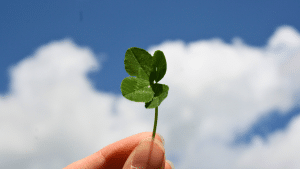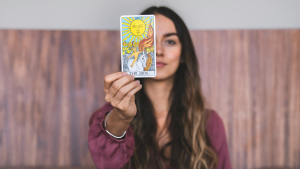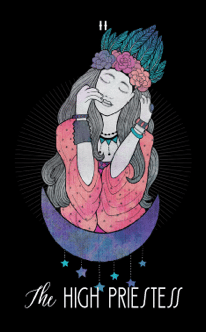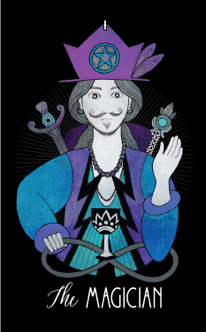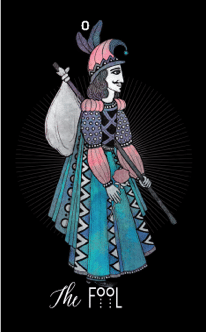A simple flip of the cards might reveal the sign you’ve been waiting for—but truly understanding tarot goes far beyond just picking up your first deck. Each card carries its symbols, imagery, and spiritual significance, creating a unique blueprint that can take time to learn.
With so many cards and layers of meaning, it can sometimes feel like the deck is speaking in riddles. That’s where our beginner’s guide comes in—to demystify the process, break down the basics, and help you understand the key differences between the Major and Minor Arcana.
How Do Tarot Cards Work?
Tarot cards are a divination tool that helps readers connect with the universe to explore specific questions or life themes, offering guided insights through a 78-card deck. Reading tarot combines memorizing the card meanings with creative interpretation, making each reading unique.
The first step to learning tarot is understanding the deck’s structure—knowing the difference between the Major and Minor Arcana—and discovering the unique archetypes and meanings of each card. Here’s your guide to get started.
Major vs. Minor Arcana: Which Tarot Cards Belong to Each Group?
For those just beginning their tarot journey, the 78-card deck can feel daunting. But once you understand how the cards are organized, the structure becomes far more approachable.
Every standard tarot deck is divided into two core groups: the Major Arcana and the Minor Arcana. Learning what each represents — and how they work together — is a foundational step toward reading tarot with clarity and confidence.
A full tarot deck consists of:
- 22 Major Arcana cards
- 56 Minor Arcana cards
The Major Arcana illustrate life’s defining moments — key lessons, soul growth, and transformative events. These cards point to the larger themes unfolding across your journey.
The Minor Arcana, on the other hand, captures the everyday — the emotions, challenges, decisions, and dynamics that shape your immediate reality. While the Major Arcana paints the broad strokes, the Minor Arcana adds detail and dimension.
For beginners, many readers suggest starting with the Major Arcana. These 22 archetypes offer a powerful introduction to tarot’s deeper meanings and symbolism, providing a strong foundation before diving into the Minor Arcana.
The Major Arcana Explained
The Major Arcana are often called the “heart” of the deck. These 22 cards represent life’s major themes and spiritual lessons — the big milestones and turning points we all experience. Think of them as the headlines in your life’s story, while the Minor Arcana fills in the details.
Each card embodies an archetype, from The Fool — symbolizing new beginnings and innocence — to The World, which marks completion and fulfillment. These cards aren’t just symbolic; they’re emotionally resonant, often jolting us into seeing things from a new angle.
The Major Arcana cards work like a universal language that connects us all through shared experiences — growth, love, loss, and transformation. When you see these cards in a reading, they often indicate significant shifts or lessons at play.
Major Arcana Tarot Card Meanings:
- The Fool — Beginnings
- The Magician — Manifestation
- The High Priestess — Intuition
- The Empress — Nurture
- The Emperor — Authority
- The Hierophant — Tradition
- The Lovers — Union
- The Chariot — Willpower
- Strength — Courage
- The Hermit — Reflection
- Wheel of Fortune — Cycles
- Justice — Balance
- The Hanged Man — Surrender
- Death — Transformation
- Temperance — Harmony
- The Devil — Temptation
- The Tower — Upheaval
- The Star — Hope
- The Moon — Mystery
- The Sun — Vitality
- Judgement — Awakening
- The World — Completion
The Minor Arcana Explained
Each card in the Minor Arcana represents a theme based on its number or court rank, while its suit reveals the emotional tone. When multiple cards share the same theme or suit in a reading, it highlights that particular energy as especially strong and deserving of your attention.
Additionally, some Minor Arcana cards connect with Major Arcana themes—look for overlapping symbols, patterns, and stories to deepen your interpretation by blending both decks’ messages.
Minor Arcana Tarot Card Meanings:
- Ace — Beginning
- 2 — Choice
- 3 — Growth
- 4 — Stability
- 5 — Conflict
- 6 — Harmony
- 7 — Reflection
- 8 — Movement
- 9 — Fulfillment
- 10 — Completion
- Page — Curiosity
- Knight — Action
- Queen — Wisdom
- King — Mastery
The Four Suits of the Minor Arcana
The 56 cards of the Minor Arcana are divided into four suits, each associated with a different realm of human life and one of the classical elements.
Each suit contains 14 cards: ten numbered cards (Ace through Ten) and four Court Cards (Page, Knight, Queen, and King), which often represent the personalities, attitudes, or people involved in a given situation.
Swords — Element of Air
Swords represent the realm of the mind: thoughts, logic, truth, communication, and conflict. This suit often deals with decision-making, tension, clarity, and mental challenge. When Swords show up, it’s time to pay attention to how you’re thinking, speaking, or cutting through confusion.
Cards in the Suit of Swords:
Ace, 2, 3, 4, 5, 6, 7, 8, 9, 10, Page, Knight, Queen, King
Pentacles — Element of Earth
Pentacles are grounded in the physical world. This suit governs career, finances, health, home, and material security. It speaks to how you build, invest, sustain, and relate to your environment and resources.
Cards in the Suit of Pentacles:
Ace, 2, 3, 4, 5, 6, 7, 8, 9, 10, Page, Knight, Queen, King
Wands — Element of Fire
Wands embody passion, drive, action, and creative energy. This suit speaks to ambition, growth, movement, and spiritual purpose. It’s the spark that initiates — and the force that keeps you going.
Cards in the Suit of Wands:
Ace, 2, 3, 4, 5, 6, 7, 8, 9, 10, Page, Knight, Queen, King
Cups — Element of Water
Cups rule over the emotional and intuitive realms: love, relationships, feelings, connection, and the subconscious. This suit reflects how we give and receive emotionally, and what we long for on a heart-soul level.
Cards in the Suit of Cups:
Ace, 2, 3, 4, 5, 6, 7, 8, 9, 10, Page, Knight, Queen, King
Seeking clarity? Let a Keen Advisor guide you — schedule your tarot reading now.


